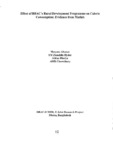| dc.contributor.author | Khatun, Masuma | |
| dc.contributor.author | Hyder, SM Ziauddin | |
| dc.contributor.author | Bhuiya, Abbas | |
| dc.contributor.author | Chowdhury, AMR | |
| dc.date.accessioned | 2019-11-13T08:25:55Z | |
| dc.date.available | 2019-11-13T08:25:55Z | |
| dc.date.issued | 1998 | |
| dc.identifier.citation | Khatun, M., Ziauddin , S., Bhuiya, A., & Chowdhury, A. (1998). Effect of BRAC’s rural development programme on calorie consumption: evidence from Matlab. Research Reports (1998): Health Studies, Vol - XXV, 82-98. | en_US |
| dc.identifier.uri | http://hdl.handle.net/10361/12943 | |
| dc.description.abstract | This report describes the association between calorie consumption and socioeconomic status indicators and examines the effect of BRAC's Rural Development Programme (RDP) membership on per capita daily calorie consumption. The analysis was based on data collected from 2, 061 households in Matlab thana during April-August, 1995 under BRAC-ICDDR,B joint research project. Socioeconomic and food consumption data were collected through home visits using pre-tested structured questionnaires. Total household calorie consumption per day was divided by household food consumption unit to obtain per capita daily calorie consumption. The results revealed that average per capita calorie consumption among the study population was 1,929 kcal (95% CI: 1,897-1,961 kcal) which is comparable to the national average of 1,943 kcal. Calorie consumption was significantly associated with household size and land holding; occupation and literacy of the household head; and monthly food and non-food expenditure (p<O.OS). The proportions of households with per capita daily calorie consumption < 1, 80 5 kcal and <2, 122 kcal were significantly lower among BRAC eligible member compared to eligible non-member households (p<0.05). Controlling for some potential confounding factors, BRAC eligible member households had 33% less chance to consume <1,805 kcal and 28% less to consume <2, 122 kcal compared to the eligible non-member hollseholds (p<Q.01). In conclusion, BRAC's RDP membership had positive effect on household level calorie consumption. However, the overall mean calorie consumption of both the BRAC member and eligible non-member households is still 83% of the recommended level. | en_US |
| dc.language.iso | en | en_US |
| dc.publisher | BRAC Research and Evaluation Division (RED) | en_US |
| dc.subject | BRAC | en_US |
| dc.subject | Rural development programme | en_US |
| dc.subject | Calorie consumption | en_US |
| dc.subject | Matlab | en_US |
| dc.subject.lcsh | Nutrition surveys | |
| dc.subject.lcsh | Older people--Nutrition | |
| dc.subject.lcsh | Rural poor--Nutrition | |
| dc.subject.lcsh | Food--Caloric content | |
| dc.title | Effect of BRAC's rural development programme on calorie consumption: evidence from Matlab | en_US |
| dc.type | Research report | en_US |

